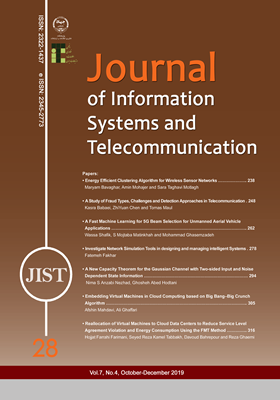Energy Efficient Clustering Algorithm for Wireless Sensor Networks
محورهای موضوعی : Wireless NetworkMaryam Bavaghar 1 * , Amin Mohajer 2 , Sarah Taghavi Motlagh 3
1 - ICT Research Institute (ITRC)
2 - Telecommunication Research Center (ITRC)
3 - Telecommunication Research Center (ITRC)
کلید واژه: Wireless Sensor Networks, , Energy-Efficient Clustering, , Cluster Head Selection, , Network Coverage, , Network Life Time, , ,
چکیده مقاله :
In Wireless Sensor Networks (WSNs), sensor nodes are usually deployed with limited energy reserves in remote environments for a long period of time with less or no human intervention. It makes energy efficiency as a challenging issue both for the design and deployment of sensor networks. This paper presents a novel approach named Energy Efficient Clustering Algorithm (EECA) for Wireless Sensor Networks which is based on two phases clustering model and provides maximum network coverage in an energy efficient way. In this framework, an effective resource-aware load balancing approach applied for autonomous methods of configuring the parameters in accordance with the signaling patterns in which approximately the same bit rate data is provided for each sensor. This resource-efficient clustering model can also form energy balanced clusters which results in increasing network life time and ensuring better network coverage. Simulation results prove that EECA is better than LEACH, LEA2C and EECS with respect to network lifetime and at the same time achieving more network coverage. In addition to obtained an optimal cluster size with minimum energy loss, the proposed approach also suggests new and better way for selecting cluster heads to reduce energy consumption of the distributed nodes resulting in increased operational reliability of sensor networks.
In Wireless Sensor Networks (WSNs), sensor nodes are usually deployed with limited energy reserves in remote environments for a long period of time with less or no human intervention. It makes energy efficiency as a challenging issue both for the design and deployment of sensor networks. This paper presents a novel approach named Energy Efficient Clustering Algorithm (EECA) for Wireless Sensor Networks which is based on two phases clustering model and provides maximum network coverage in an energy efficient way. In this framework, an effective resource-aware load balancing approach applied for autonomous methods of configuring the parameters in accordance with the signaling patterns in which approximately the same bit rate data is provided for each sensor. This resource-efficient clustering model can also form energy balanced clusters which results in increasing network life time and ensuring better network coverage. Simulation results prove that EECA is better than LEACH, LEA2C and EECS with respect to network lifetime and at the same time achieving more network coverage. In addition to obtained an optimal cluster size with minimum energy loss, the proposed approach also suggests new and better way for selecting cluster heads to reduce energy consumption of the distributed nodes resulting in increased operational reliability of sensor networks.
[1] El-mawla, Nesma Abd, Mahmoud Badawy, and Hesham Arafat. "SECURITY AND KEY MANAGEMENT CHALLENGES OVER WSN (ASurvey)." International Journal of Computer Science & Engineering Survey (IJCSES) 10, no. 1 (2019): 15-34.
[2] Mohajer, Amin, Maryam Bavaghar, Rashin Saboor, and Ali Payandeh. "Secure dominating set-based routing protocol in MANET: Using reputation." In 2013 10th International ISC Conference on Information Security and Cryptology (ISCISC), pp. 1-7. IEEE, 2013.
[3] Singh, Omkar, and Vinay Rishiwal. "QoS Aware Multi-hop Multi-path Routing Approach in Wireless Sensor Networks." International Journal of Sensors Wireless Communications and Control 9, no. 1 (2019): 43-52.
[4] Habib, Md Ahsan, and Mohammad S. Hasan. "A performance analysis of backbone structures for static sink based starfish routing in wsn." In 2017 4th International Conference on Networking, Systems and Security (NSysS), pp. 1-6. IEEE, 2017.
[5] Ghosh, Indranil. "Study on hierarchical cluster-based energy-efficient routing in wireless sensor networks." International Research Journal of Engineering and Technology (IRJET) 5 (2018): 688-691.
[6] Mohajer, Amin, Morteza Barari, and Houman Zarrabi. "An Efficient Resource Allocation Mechanism including Load-aware Handover Decision." [7] Nam, Deok. "Comparison Studies of Hierarchical Cluster-Based Routing Protocols in Wireless Sensor Networks." Proceedings of 35th International Confer 69 (2020): 334-344.
[8] Kaur, Khushpreet, and Er Lovepreet Kaur. "Energy Effıcıent Protocol On Wıreless Sensor Network: A Revıew." International Journal of Scientific Research in Science, Engineering and Technology 3, no. 3 (2017): 40-46.
[9] Shukla, Anurag, and Sarsij Tripathi. "An Effective Relay Node Selection Technique for Energy Efficient WSN-Assisted IoT." Wireless Personal Communications (2020): 1-31.
[10] Ramesh, Dr V. "Energy-Efficient Clustering Scheme (EECS) With Secure Data Aggregation for Mobile Wireless Sensor Networks." International Journal of Electrical Electronics & Computer Science Engineering 4, no. 5 (2017).
[11] Sohan, Radhika, Nitin Mittal, Urvinder Singh, and Balwinder Singh Sohi. "An Optimal Tree-Based Routing Protocol Using Particle Swarm Optimization." In Nature Inspired Computing, pp. 117-124. Springer, Singapore, 2018.
[12] Swathi, N., S. Santosh Kumar, KN Sunil Kumar, and P. Rajendra Prasad. "Zone based hierarchical energy efficient clustering scheme for WSN." In 2016 IEEE International Conference on Recent Trends in Electronics, Information & Communication Technology (RTEICT), pp. 136-140. IEEE, 2016.
[13] Aksu, Gökhan, Cem Oktay Güzeller, and Mehmet Taha Eser. "The Effect of the Normalization Method Used in Different Sample Sizes on the Success of Artificial Neural Network Model." International Journal of Assessment Tools in Education 6, no. 2 (2019): 170-192.
[14] Gui, Guan, Hongji Huang, Yiwei Song, and Hikmet Sari. "Deep learning for an effective nonorthogonal multiple access scheme." IEEE Transactions on Vehicular Technology 67, no. 9 (2018): 8440-8450.

